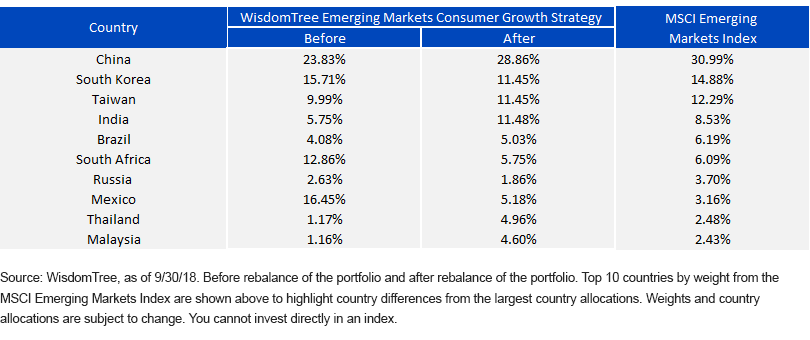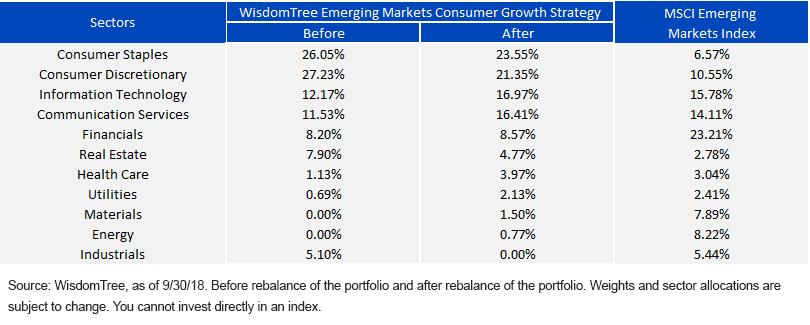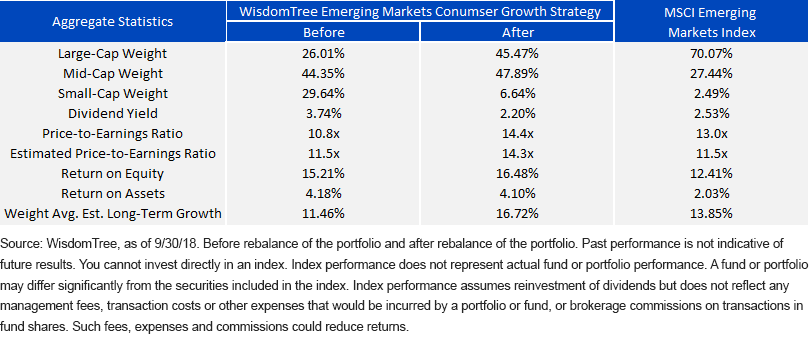Introducing Our New Active Approach to Emerging Market Consumer Investing


WisdomTree aspires to be at the forefront of innovative ways for marrying the benefits of the exchange-traded fund (ETF) structure with goals that are associated with active managers, such as outperforming market cap-weighted indexes over the long run. We call this approach to investing Modern Alpha™.
In 2013, WisdomTree launched the WisdomTree Emerging Markets Consumer Growth Fund (EMCG) to help investors capitalize on emerging market consumer growth trends, while at the same time maintaining a sensitivity to valuation. The investment thesis was straightforward; emerging markets have growing populations with the potential for increasing incomes over time, so consumer-focused stocks should be able to benefit.
At that time, there was already a strategy in the market with over $1 billion tracking the Dow Jones Emerging Markets Consumer Titans 30 Index. The methodology was simple; essentially, include the largest 30 stocks within the two consumer-focused sectors, Consumer Discretionary and Consumer Staples. We at WisdomTree felt we could improve on this methodology by broadening the basket to include stocks outside of the consumer sectors that can also benefit from this rising middle class and by taking a more fundamental approach—focusing on quality growth companies while remaining sensitive to valuations. We are pleased to say that, since its inception, EMCG has outperformed the Dow Jones EM Consumer Index, but both have underperformed the de facto benchmark, the MSCI Emerging Markets Index. Neither strategy was able to capture the momentum in Chinese information technology that has dominated the broad-based cap weighted-index over the past few years.
New Quant Active Approach
It’s always easy to be a Monday morning quarterback and look back over the past five years to see reasons for underperformance that won’t always translate to future outperformance, but we think we can do better while keeping the investment process similar. What we learned running this strategy in a purely passive form is that it is difficult to balance the “right” allocation among sectors and countries, and sometimes the rules produce unintended allocation bets, which we can constrain better in a structured active approach. The spirit of the quantitative approach remains the same by focusing on the following:
- Quality: We are still screening for higher-quality securities, but instead of just using three-year averages for return on equity (ROE) and return on assets (ROA), we are incorporating our new quality factor, which looks at static observations and trends of ROE, ROA, gross profits over assets and cash flow over assets.
- Growth: Instead of relying on longer-term growth estimates from analysts, we are looking at static observations and historical trends of net income and sales growth. We believed the coverage in the longer-term earnings growth estimates weren’t as robust in the emerging market space, especially for mid- and small-cap equities.
- Revenue: We are still focused primarily on emerging markets equities that have most of their revenue coming from within emerging market countries because these are the companies that should benefit from an increase in consumption.
- Valuations: Previously part of the composite rank considered earnings yield and, ultimately, we weighted the strategy by net income, which tilted the portfolio to the higher-earnings yield equities. While earnings yield is still an important factor in investing in general and especially in value investing, our goal here is to capture higher-quality growth firms and lean into the growth instead of away. Going forward, the weighting will consider the composite quality and growth rank while also incorporating the size of the company.
- Sector: While we are still focused on equities in the consumer sectors, we are broadening the basket to include equities outside of the two consumer sectors without hard caps or cutoffs that are required in a passive structure.
- Country: While we will let the stock selection drive the country allocations, we will have the flexibility to increase or decrease the allocation risk, typically constraining differences to a maximum of 5%.
After running through the new quant model and making some minor active risk adjustments, we are excited to present the results and aggregate valuations.
Figure 1: Country Allocations

From a country perspective, China remains the largest weight, but the under-weight position relative to the market cap-weighted index was decreased. Within this aggregate China exposure is approximately a 5% weight to domestically listed A-share equities, which we believe provides unique access to more domestically sensitive equities. Another noticeable change was an increased weight to India, one of the largest population bases in the world, with a strong consumption-based economy that’s only expected to grow further. Substantial over-weights in South Africa and Mexico were lowered, decreasing the allocation risk associated with those countries.
Figure 2: Sector Allocations

As you can see in the table above, the strategy is still focused heavily on the consumer with the Consumer Staples and Consumer Discretionary sectors making up the top two sector allocations. While these remain over-weight relative to the market cap-weighted index, we removed the 60% allocation requirement the previous index methodology had in an order to broaden the basket further. We increased the weight to the Information Technology and Communication Services sectors. The increased weight to the Communication Services sector includes companies like Tencent and Baidu, formerly classified as Information Technology, but they are still critical companies likely to grow right along with the emerging market consumer. One of the largest under-weights remains Financials, but given the strategy mandate we believe the allocation for China is better served in private consumer-focused stocks and not in state-owned banks.

Even though the strategy is now active, investors can see the full details of EMCG’s holdings every day on our website along with its fundamental attributes. The fundamental attributes of the portfolio show that this basket of equities now trades at a slightly higher market multiple, which was expected with the tilt away from the value-weighting scheme of the index . Considering that we are trying to lean into growth and quality, we are comfortable with the higher valuations, especially since the quality and growth characteristics remain strong and have improved. The strategy also reduced some of its size bias but remained over-weight in mid-cap securities, which tend to be more domestically sensitive than the largest-capitalization global securities.
Again, WisdomTree believes that by combining the quantitative nature that our indexing business was based on while utilizing the structure of the ETF, we can create a unique, Modern Alpha™-oriented approach for active equity ETFs. WisdomTree is excited to be pioneering this stage for actively managed portfolios in the ETF structure, and this represents the latest addition to our lineup.
Important Risks Related to this Article
There are risks associated with investing, including possible loss of principal. Foreign investing involves special risks, such as risk of loss from currency fluctuation or political or economic uncertainty. Funds focusing on a single sector and/or smaller companies generally experience greater price volatility. Investments in emerging, offshore or frontier markets are generally less liquid and less efficient than investments in developed markets and are subject to additional risks, such as risks of adverse governmental regulation, intervention and political developments. Due to the investment strategy of this Fund, it may make higher capital gain distributions than other ETFs. Please read the Fund’s prospectus for specific details regarding the Fund’s risk profile.


